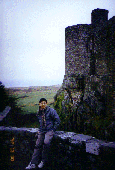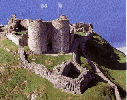|
CYMRU LAND OF SAINTS AND HEROES Tan Wee Cheng's journey through the history & culture of Wales |
|
CYMRU LAND OF SAINTS AND HEROES Tan Wee Cheng's journey through the history & culture of Wales |
Stones, Statesmen, 10,000 Saints
and a Mysterious Isle:
Across Snowdonia & Anglesey
Dolgellau in southern Snowdonia was the first town we passed. Owain Glyndwr once had his capital here. Narrow wounding streets through stone houses...pristine though foggy mountain air - this is a beautiful little town and modern tourism has bestowed it with many B&Bs. It was hard to believe that, the only industries that kept these parts alive a hundred years ago were agriculture and mining. Nice place it was, but modern-day travellers (as we trashy tourists would like to be known) like us have much to cover in a very short time, and hence we stopped only long enough to draw some money from the ATM and stock up on some Vitamin C's. In any case, if LP is to be believed, local legends say that if one spends the night up on the Cadair Idris (Snowdonia's 2nd highest peak) near here, he would wake up either as a poet or go mad. So, which do you prefer?
 [Harlech Castle on the
left, click to expand pix]
[Harlech Castle on the
left, click to expand pix]
We then drove westwards and downhill along the Vale of Ffestiniog, that narrow picturesque inlet of water that once brought building slate from the Caverns of Blaenau Ffestiniog to the port of Portmadog on the Irish Sea, to grace the roofs of grand cathedrals and ordinary houses of Cologne, Berlin, Sydney and Auckland. Today, the port of Portmadog is a cute little tourist town, which like all others in the region, is crowded with B&Bs.
Nearby is the Italianate village of Portmeirion, built by Welsh architect Sir William-Ellis. A little Ligurian village under the grey skies of the Irish Sea. A little tacky, eccentric place, but no harm visiting. Nearby is the village of Llanystundwy, where David Lloyd George, one of UK's most famous prime minister, grew up. PM during the First World War, he remained a staunch Welshman and a fluent Welsh-speaker even as he held the reins of power over the British Empire.
We stopped by the spectacular Harlech perched on the rock - that invincible-looking castle overlooking the entrance of the Vale of Ffestiniog. This squarish, symmetrica l masterpiece was built in the 1280s by the invading English. By no means infallible, it was captured by Owain Glyndwr, Yorkists and finally the Parliamentarians of the English Civil War. Great place for pictures and don't miss the sand dunes below the cliff.
 The Ilyn Peninsula was
next - this is a legendary land where the mountains meet the
coast. Green mountains and little hills, miles of sandy beaches,
and lots of meadows with cows and sheep. This is also a land of
holiness - Bardsey Island at Llyn 's tip was a burial place for
bishops, and hence its nick name - "Isle of Ten Thousand
Saints". A pilgrimage to the island was once rumoured to be
equal to once to Rome. Llyn is also the most Welsh-speaking
region of the land - Llywelyn the Great once held court at the
beautiful, currently ruined seaside castle of Criccieth (pix to
the right - from CADW), and the town of Pwllheli on the Peninsula
was where the Welsh nationalist party, Plaid Cymru, was formed in
1925.
The Ilyn Peninsula was
next - this is a legendary land where the mountains meet the
coast. Green mountains and little hills, miles of sandy beaches,
and lots of meadows with cows and sheep. This is also a land of
holiness - Bardsey Island at Llyn 's tip was a burial place for
bishops, and hence its nick name - "Isle of Ten Thousand
Saints". A pilgrimage to the island was once rumoured to be
equal to once to Rome. Llyn is also the most Welsh-speaking
region of the land - Llywelyn the Great once held court at the
beautiful, currently ruined seaside castle of Criccieth (pix to
the right - from CADW), and the town of Pwllheli on the Peninsula
was where the Welsh nationalist party, Plaid Cymru, was formed in
1925.
 [Symbol of Plaid Cymru] Leaving Llyn, we proceeded
northwards towards Bangor, and paid a short visit to the Isle of
Anglesey. Ynys Mon - also known as Mon Mam Cymru - Mother of
Wales, for its fertility and legendary status as the birthplace
of the Welsh People and seat of the patriotic princes of Gwynedd.
This was also the centre of the Druids - the religious leaders of
Celtic Britain. The Romans wrote about their human sacrifices
while the New Age yuppie junkies talk about the sophisticated
spirituality of these gurus.
[Symbol of Plaid Cymru] Leaving Llyn, we proceeded
northwards towards Bangor, and paid a short visit to the Isle of
Anglesey. Ynys Mon - also known as Mon Mam Cymru - Mother of
Wales, for its fertility and legendary status as the birthplace
of the Welsh People and seat of the patriotic princes of Gwynedd.
This was also the centre of the Druids - the religious leaders of
Celtic Britain. The Romans wrote about their human sacrifices
while the New Age yuppie junkies talk about the sophisticated
spirituality of these gurus.
After a drive around the unusually flat isle and its adjoining Holy Island (and its port Holyhead where people take the ferry to Ireland), we had a traditional Welsh meal at the little village of Llanpwllgwyngyllgogerychwyrndrobwllllantysiliogogogooch (meaning "St Mary's Church in the hollow of the White Hazel near a rapid whirlpool and the Church of St Tysilio near the Red Cave"). Generally shortened to Llanfair PG or Llanfairpwll, this is the longest place name in Britain, and smart entrepreneurs built a factory outlet shopping centre next to the railway station, further attracting many tourists who arrive daily by bus.
Click to see the longest place name in UK !
Click to expand ! [WTB brochure]